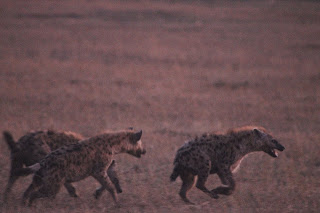While on our morning observation yesterday, Benson and I had the joy of finding 5 hyenas on top of a
very dead, very putrid vulture. While looking through our binoculars to ensure
no subtle behaviors were missed, we were simultaneously trying (and failing) to
cover our noses from the horrible smell. However, the hyenas didn’t seem to mind
the smell, in fact they seemed to enjoy it. At first, it was difficult to tell
if the hyenas had acquired the bird with intent to eat it, or if they were
merely playing with it. Behaviors that we would typically classify as
aggressions (e.g. snaps, bites, chases, and lunges) appeared to be being
exhibited, but the recipient of the behavior never exhibited the submissive
behaviors typically seen after an aggression (e.g. laying ears against the
head, grinning, giggling, defensive parrying). With hyenas with ranks all
across the board, it was quite odd at first to not see any submissive behaviors
being displayed from the lower ranking individuals. In fact, it appeared that
all five individuals (Arby’s, Athi, Complex, Eowyn, and Richard Hatch) were all
excitedly vying for their turn to roll in the carcass and cover themselves in
the smell of dead bird. After witnessing a few interactions that we initially
thought were aggressive in nature, we were able to discern that these hyenas
were indeed playing with not only each other but also the vulture carcass.
Play behavior is commonly seen during the development of
mammalian species and is typically seen in juveniles. Adult social play has
been observed in multiple mammalian species, including spotted hyenas (Estes,
2012). Play behaviors are often high energy – e.g. running or chasing, and
overall result in a net loss of energy for the individual(s) involved. So why
waste the energy, especially in this case where there was a seemingly perfect
energy source present? Since it’s so initially costly, it’s thought that play
behaviors function to fine tune animals to situations they will experience
later in life (Nunes et al. 2002). In
a gregarious animal like the spotted hyena, social play, like we saw yesterday,
probably functions to establish relationships with other individuals in the
social group (Holmes 1994, 1995). It’s also thought that certain play behaviors
allow the players to strengthen their motor skills (Nunes et al. 2002) so that they’re better equipped to deal with
situations in which those behaviors could help the individual defend themselves,
territory, or a kill (in the case of hyenas). As for the function of rolling in
a dead bird, it’s possible we’ll ever know. Maybe the smell is just as enticing
to hyenas as it is revolting to us!
 |
| Complex and Richard Hatch appear to lunge at Arby's, who leaps away from their playful advance. |
 |
| Everyone (not so patiently) waits for their turn to roll in the dead vulture. |
 |
| Athi and Richard Hatch chase Arby's in circles around the dead vulture. |
 |
| Hyena play pile! |
 |
Arby's playfully lunges at Athi while Richard Hatch sticks sticks his nose under Arbys' tail.
|
 |
| It's hard to be upset about the smell of the dead vulture when this is providing the lighting for the whole scene. |











No comments:
Post a Comment